There has been significant research dedicated towards computing the crossing numbers of families of graphs resulting from the Cartesian products of small graphs with arbitrarily large paths, cycles and stars. For graphs with four or fewer vertices, these have all been computed, but there are still various gaps for graphs with five or more vertices. We contribute to this field by determining the crossing numbers for fifteen such families.
Consider a graph G comprising vertices V(G) and edges E(G). A drawing of G onto the plane is a mapping DG which maps vertices to distinct points and edges to continuous arcs. The image of an edge e = {u, v} is a continuous arc between the points associated with u and v such that the interior of the arc does not contain any points associated with vertices. without loss of generality, we call the points and arcs the ‘vertices’ and ‘edges’ of the drawing. The interiors of the edges are allowed to intersect at singleton points in such a way that each edge intersection is strictly a crossing between the edges, as opposed to the edges touching and then not crossing. For simplicity, we assume that no three edges intersect at the same point. These intersections form the crossings of the drawing and the number of crossings in D is denoted by crD(G). The crossing number of G, denoted cr(G), is the minimum number of crossings over all possible drawings. The crossing number problem (CNP) is the problem of determining the crossing number of a graph, and is known to be NP-hard [1]. The CNP is a notoriously difficult problem even for relatively small graphs; indeed, the crossing number of K13 has still not been determined [2].
The Cartesian product of two graphs G and H, denoted by G□H, is a graph with vertex set V(G) × V(H), such that an edge exists between vertices (u, u′) and (v, v′) if and only if either u = v and {u′, v′} ∈ E(H), or u′ = v′ and {u, v} ∈ E(G). An example of the Cartesian product of two paths, P3□P4, is displayed in Figure 1. Note that Pn is the path on n + 1 vertices.
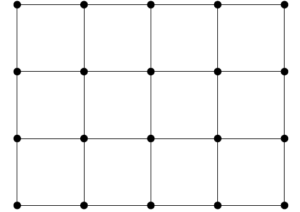
One of the early results relating to crossing numbers is due to Beineke and Ringeisen [3] who, in 1980, considered families of graphs resulting from the Cartesian products of connected graphs on four vertices with arbitrarily large cycles. There are six connected graphs on four vertices, and with only one exception (the star S3), they were successful in determining the crossing numbers for each resulting family. The one unsolved case was subsequently handled by Jendrol and Šcerbová [4] in 1982. A decade later in 1994, Klešč [5] extended this result by determining the crossing numbers of families resulting from the Cartesian products of each of the connected graphs on four vertices with arbitrarily large paths and stars. In the ensuing years, significant effort has gone into extending these results to include graphs on more vertices; in particular five and six vertices. The pioneering work in this area was by Klešč and his various co-authors [5, 6, 7, 8, 9, 10, 11, 12, 13, 14, 15, 16, 17, 18, 19, 20, 21, 22, 23, 24, 25, 26, 27] who have spent the last three decades handling these cases, often on a graph-by-graph basis, requiring ad-hoc proofs that exploit the specific graph structure of the graphs in question. In the last fifteen years, a large number of other researchers have also contributed to this field. However, communication between the various researchers in this area has been poor, and it is has not been uncommon for multiple researchers to publish identical results.
To address this issue, a dynamic survey [28]on graphs with known crossing numbers was recently produced, which included tables of all known results of crossing numbers of families resulting from Cartesian products of small graphs with paths, cycles and stars. We reproduce the tables for crossing numbers of Cartesian products involving graphs on six vertices here. They are separated into Cartesian products involving paths (Table 1), cycles (Table 2) and stars (Table 3). In Tables 1–3, only those graphs for which results have been determined are included. The graph indices are taken from Harary [29], and an illustration of each graph on six vertices, as well as citations for each of the results in Tables 1–3 may be found in [28]. Note that, up to isomorphism, there are 156 graphs on six vertices, which includes 112 connected graphs.
For completeness, the tables include results determined in this paper
and we highlight these indices in boldface. Additionally, note that some
of the results are marked with asterisks. This indicates that the
corresponding results appeared in journals which do not have adequate
peer review processes. Hence, it would be valuable if these results
could be re-proved in a journal which is fully peer reviewed. Indeed, in
the present work, we provide a proof for one such asterisked result from
[30], namely
Proving that a particular graph family has crossing number equal to a
particular function is usually achieved as follows. First, an upper
bound for the crossing number is determined by providing a drawing
method for members of that family which realises the proposed number of
crossings. This is then shown to coincide with a lower bound, which is
usually determined by some form of inductive argument. The latter
typically takes much more work than the former. However, in some cases,
a lower bound can be easily determined. For instance, consider
Furthermore, it is also clear that
In what follows, we use approaches similar to the previous paragraph to determine the crossing number for fifteen additional families of graphs. Although the arguments are not complicated, the extensive research into filling in the gaps of Tables 1 – 3, which continues to this day, indicates the interest in this area; despite all of that research, these results have been hitherto undiscovered. We are in a unique position to present these simple arguments for two reasons. First, we are able to take advantage of the recently produced dynamic survey [28]] that gathers, for the first time, all known published results into one place, so that they can all be simultaneously drawn upon to provide good lower bounds. Second, we are also able to take advantage of the recently developed crossing minimisation heuristic, QuickCross [31], to aid us in finding good upper bounds.
In this section we determine the crossing numbers of the Cartesian product of one of the graphs displayed in Figure 2, with various arbitrarily large paths, cycles and stars.
The upcoming proofs are laid out as follows. In Theorem 1 the crossing numbers of

Theorem 1. Consider the path graph Pn for n ≥ 1. Then, cr(
Proof. Consider the graph
Theorem 2. Consider the cycle graph Cn for n ≥ 6. Then, cr(G596□Cn) = cr(
Proof. Consider graphs G406 and G1136,
displayed in Table 2. The crossing
number cr(G406□Cn) = 4n
for n ≥ 6 was determined by
Richter and Salazar [32], and the crossing number cr(G1136□Cn) = 4n
for n ≥ 3 was determined by
Klešč and Kravecová [20]. Then, consider graphs G596,
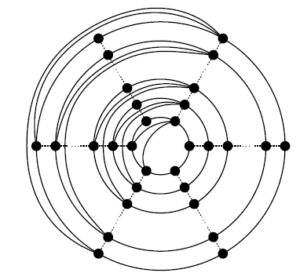

Theorem 3. Consider the cycle graph Cn. Then:
cr(
cr(
cr(
cr(
cr(
cr(
Proof. Consider graphs
If we use ⊂ to denote subgraphs,
then the following can be easily verified. First,

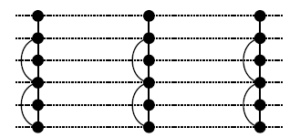
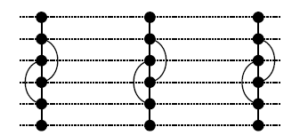
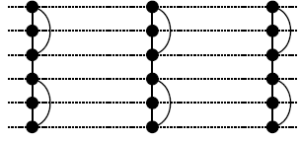
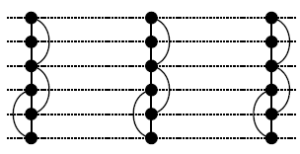

Each of the results in Theorems 2 and 3 is stated for the Cartesian product of a graph and a sufficiently large cycle. However, for small cycles, the results are not provided in those Theorems. We present them now in Table 4.
Remark 1: To verify that the numbers provided in Table 4 are correct, we have submitted each graph to Crossing Number Web Compute [33, 34], an exact solver designed to handle sparse instances of small to moderate size. The proof files are available upon request from the corresponding author.
Theorem 4. Consider the star graph Sn for n ≥ 1. Then,
Proof. Consider the graph G276, which is
displayed in Table 3. The crossing
number

1970-2025 CP (Manitoba, Canada) unless otherwise stated.